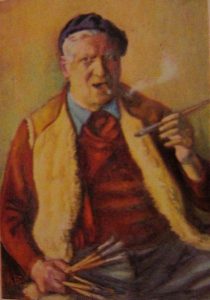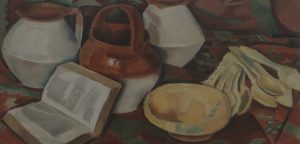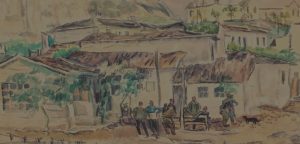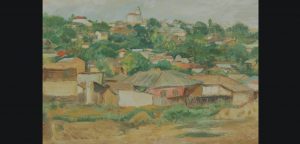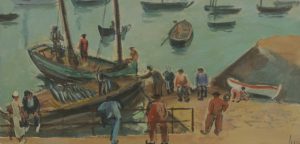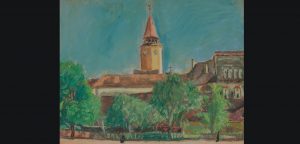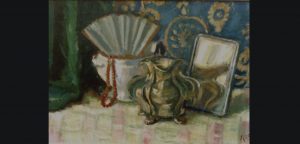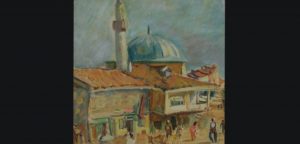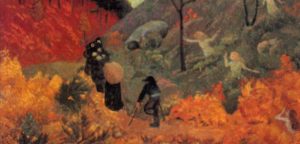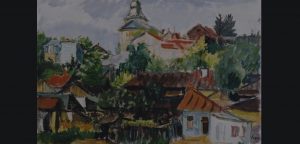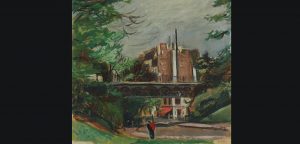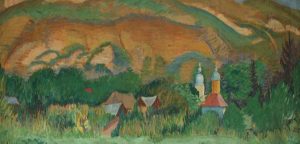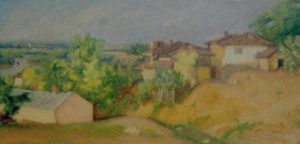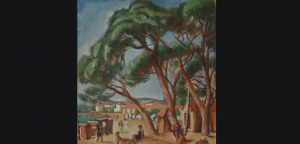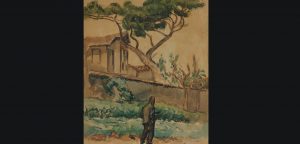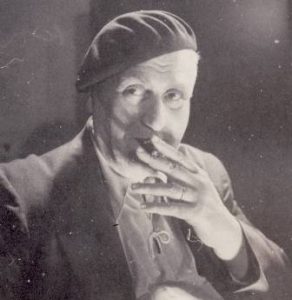Iosif Iser was born on the 21st of May in 1881 in Bucharest.
1881 - 1958
Iosif Iser
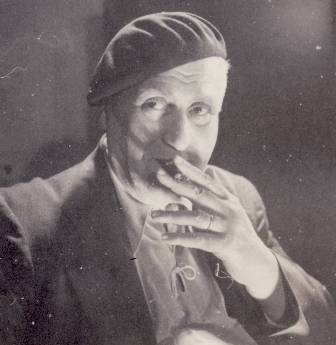
description
An outstanding Romanian artist, graphic artist and illustrator of Jewish origin.
The childhood of the future master was held in the city of Ploiesti. There he received a secondary education. Since from an early age, Joseph loved to draw and had a talent for this, he started working as a window dresser and poster designer.
One of the most prolific painters of Romania of the 20th century, who achieved fame in Europe, worked in all genres, painting many portraits, including nudes, landscapes of his country, France and Spain, interior and genre scenes, still lifes. The expressionist artist who became a founding member of the association “Arta” (“Art”) that received the title of “People’s”, played a major role in shaping and promoting contemporary visual art in Romania.
Key ideas:
– Romanian-Jewish artist Iosif Iser actually “poured” Expressionism in the art of his country, in all genres. The artist was a generalist – he painted and drew pictures, worked in the plot and portrait genres, painted urban and rural landscapes. Due to the human nature and the characteristics of his artistic talent, Iser often provoked his audience and even the whole society.
– Some critics believed that he abused some people by his painting manner. However, the public mostly cared for the emotional aspect of his painting and its truth. Starting his first series depicting the life and customs of the local Tatars, giving expressive portraits of rabbis and other ordinary people in no less simple surroundings, the young author really painted them. In these works, a characteristic style is visible – the freedom of the manner of applying paints itself, the active sonority of a color and a bold contour line highlighting the elements of the composition.
– During the “French” period, geometric elements are included in his works, but the paintings remain figurative. From the beginning of the 1920s, when the artist still depicted the life of Tatars of Balchik and Dobrudzhi, new themes were wedged into his works and also became permanent – a series with ballerinas and heroes of the eternal triangle – Harlequin, Pierrot and Kolombina (“Harlequinad”). In these works, the artist showed himself as a skillful stage director. He depicted ballerinas as not festive ones, not on the stage, but at work or, more often, having rest after work – then their poses are relaxed, like of his half-naked odalisque, lying on wide sofas. In most cases, the master chose a dim chromatic harmony; those colorful blotches are more like dialogues than contrasts to primary pastel colors. For nude portraits, the master also thought through unusual angles and poses – for example, “Nude, reading a book” sits with his back to the viewer.
– A brighter palette returns to works dedicated to Spain (1930s), mostly it is seen in the images of bullfighters and landscapes of the city of Toledo. Women of this country in their black robes look exotic and characteristic: restrained southern passion is read only in their tense postures and strict faces.
– At the beginning of his career, I. Iser became famous for his almost rude caricatures, where the mocked phenomenon or politicians (sometimes celebrities) are captured accurately and depicted with a great skill. The artist was a true expressionist, no matter what genre he chose and whatever technique he used.
1881
1898 - 1904
1904
1906
1907
1909
1913
1914 - 1920
1921 - 1924
1925 - 1929
1930 - 1933
1934
1936 - 1937
1943
1950
1958
The birth of the artist
He won a scholarship for himself - a grant for education
He took part in a competition held by the art association «Creative Youth» just for fun and unexpectedly won a scholarship for himself – a grant for education. In the Royal Munich Academy of Arts, famous artists Johann Caspar Herterich, Anton Azhbe, and Nicolas Gizis became his pedagogues.
Organized his first personal vernissage of 85 paintings
Returned to Romania and organized his first personal vernissage of 85 paintings in Ploiesti; the following year Iser moved to Bucharest to work as a caricaturist at the newspaper «Truth», and at the same time collaborated with the capital’s magazines «Ant», «Eastern Belgium”, created anti-monarchist accusatory paintings, political cartoons.
«Tinerimii artistice»
Participated in the exhibition of the association “Tinerimii artistice” (Artistic Youth), held a personal exhibition – the first in Bucharest. He traveled around the country a lot, painted landscapes, villagers, most often visited the Dobrogea region – a historic district in the north of the Balkans.
Decided to continue his studies in Paris
Decided to continue his studies in Paris, where he first started working as a cartoonist at satirical magazines; in the next year, he entered the private Academy, which was founded by Paul Ranson in Montparnasse.
Returned home
Returned home and organized the first collective exhibition of modern art in the capital (Athenaeum Palace), where, together with his works, he exhibited works by his French friends Derain and Foreing. Began to collaborate with the socialist magazine «Facla» (Torch).
«Figuri contimporane»
Managed to hold a solo exhibition before the war and to release the separate album “Pictures of a Contemporary” (“Figuri contimporane”), which included more than fifty portraits published in the magazine “Torch”.
He was drafted into the army
He was drafted into the army, participated in the actions of the Moldavian front, continuing to paint – his models were his comrades, the plots for genre paintings were front scenes (“German prisoners under guard” and others). Despite the war, two personal events of Iser took place in Bucharest. After peace came, he returned to his favorite themes – the demonstration of the life of the people; he often visited the annexed Balchik, a port on the Black Sea.
“The Tatar Family”
Having donated his most famous painting “The Tatar Family” from the “Dobruja” period to the national museum, he went to France for a long time and began to study there again – this time he went to the Free Academy of Friesz in Paris. The Ministry of Romania purchased his work from the exhibition at the Hall of Mozart for the National Art Gallery (Bucharest, 1923).
Participated in the show of the Berlin Secession
Participated in the show of the Berlin Secession, in the International Exhibition in Dresden, exhibited his paintings at the Tuileries Salon, at the National Gallery de Gets, Devanbe and Bernheim galleries, at the same time sending works to exhibitions in Bucharest. The canvas “Harlequinad” was acquired by the National Bank of his country.
Iser visited Spain
The paintings of the artist were exhibited, apart from Bucharest and Paris, in Amsterdam and Antwerp, The Hague and Brussels. Iser visited Spain, creating a large series of Toledo landscapes, portraits of bullfighters and Spanish women.
Finally, as a mature master, he returned to Romania
Finally, as a mature master, he returned to Romania, held a large retrospective exhibition of 450 paintings of different periods (Bucharest, House of Artists, 1936). Romanian museums and galleries bought a few paintings.
He took part in the International Exhibition in Paris
Established together with his colleagues and friends G. Petrashka, K. Ress, J.A. Steriadi, S. Popescu the group “Arta” (“Art”). He took part in the International Exhibition in Paris, where he was awarded the Grand Prix.
In Bucharest, there was his personal exhibition "Light and Color"
During the Second World War, the Jewish artist managed to avoid persecution. In Bucharest, there was his personal exhibition “Light and Color”. He was awarded “for merits in the field of culture” the Order “Crown of Romania” in 1947, gifted his painting to the Museum of Art of Tel Aviv; a year later, he held a personal exhibition at the New York gallery of Arnold Seligman.
He received the title of "Honored Artist" and "Order of Labor"
He received the title of “Honored Artist” and “Order of Labor”, then the State Prize and the title “People’s Artist”; He was elected a full member of the Romanian Academy. Participated in the Venice Biennale in 1954; exhibitions took place in Moscow and Leningrad (1956), in Vienna (1957).
The death
He died on the 25th of April in 1958 in Bucharest.

